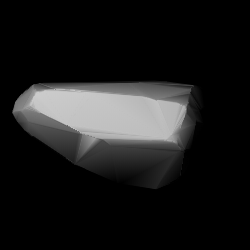Astronomy:136 Austria
 3D convex shape model of 136 Austria | |
| Discovery[1] | |
|---|---|
| Discovered by | Johann Palisa |
| Discovery site | Austrian Naval Obs. |
| Discovery date | 18 March 1874 |
| Designations | |
| (136) Austria | |
| Named after | Austria |
| A874 FA; 1950 HT | |
| Minor planet category | main-belt[1][2] · (inner) background[3] |
| Orbital characteristics[2] | |
| Epoch 23 March 2018 (JD 2458200.5) | |
| Uncertainty parameter 0 | |
| Observation arc | 141.11 yr (51,539 d) |
| |{{{apsis}}}|helion}} | 2.4812 AU |
| |{{{apsis}}}|helion}} | 2.0927 AU |
| 2.2869 AU | |
| Eccentricity | 0.0849 |
| Orbital period | 3.46 yr (1,263 d) |
| Mean anomaly | 102.82° |
| Mean motion | 0° 17m 6s / day |
| Inclination | 9.5788° |
| Longitude of ascending node | 186.46° |
| |{{{apsis}}}|helion}} | 2024-Feb-24 |
| 132.95° | |
| Physical characteristics | |
| Mean diameter | 40.14±1.0 km[2] 40.14 km[4] |
| Mass | 6.8×1016 kg |
| Rotation period | 11.4969 h (0.47904 d)[2] |
| Geometric albedo | 0.1459±0.007[2] 0.1459[4] |
| M[4] | |
| Absolute magnitude (H) | 9.69 |
Austria (minor planet designation: 136 Austria) is a main-belt asteroid that was found by the prolific asteroid discoverer Johann Palisa on 18 March 1874, from the Austrian Naval Observatory in Pola, Istria.[5] It was his first asteroid discovery and was given the Latin name of his homeland.
Based upon its spectrum, it is classified as an M-type spectrum, although Clark et al. (1994) suggest it may be more like an S-type asteroid.[6] It shows almost no absorption features in the near infrared, which may indicate an iron or enstatite chondrite surface composition. A weak hydration feature was detected in 2006.[7]
Photometric observations of this asteroid at the European Southern Observatory in 1981 gave a light curve with a period of 11.5 ± 0.1 hours and a brightness variation of 0.40 in magnitude.[4] As of 2013, the estimated rotation period is 11.4969[8] hours.
References
- ↑ 1.0 1.1 "136 Austria". Minor Planet Center. https://www.minorplanetcenter.net/db_search/show_object?object_id=136. Retrieved 29 May 2018.
- ↑ 2.0 2.1 2.2 2.3 2.4 "JPL Small-Body Database Browser: 136 Austria". Jet Propulsion Laboratory. https://ssd.jpl.nasa.gov/sbdb.cgi?sstr=2000136. Retrieved 29 May 2018.
- ↑ "Asteroid 136 Austria". Small Bodies Data Ferret. https://sbntools.psi.edu/ferret/SimpleSearch/results.action?targetName=136+Austria. Retrieved 29 May 2018.
- ↑ 4.0 4.1 4.2 4.3 Schober, H. J. (January 1983), "Rotation periods and lightcurves of the asteroids 136 Austria and 238 Hypatia", Astronomy and Astrophysics 117 (2): pp. 362–364, Bibcode: 1983A&A...117..362S.
- ↑ Albrecht, R. et al. (July 2001), "Early asteroid research in Austria", Planetary and Space Science 49 (8): pp. 777–779, doi:10.1016/S0032-0633(01)00027-7, Bibcode: 2001P&SS...49..777A.
- ↑ Clark, B. E. et al. (March 1994), "Infrared Spectral Observations of Smaller (50 km) Main Belt S, K, and M Type Asteroids", Abstracts of the 25th Lunar and Planetary Science Conference, held in Houston, TX, 14–18 March 1994: pp. 265–266, Bibcode: 1994LPI....25..265C.
- ↑ Hardersen, Paul S.; Gaffey, Michael J.; Abell, Paul A. (January 1983), "Near-IR spectral evidence for the presence of iron-poor orthopyroxenes on the surfaces of six M-type asteroids", Icarus 175 (1): pp. 141–158, doi:10.1016/j.icarus.2004.10.017, Bibcode: 2005Icar..175..141H.
- ↑ Behrend, Raoul (in French), Courbes de rotation d'astéroïdes et de comètes, Observatoire de Genève, http://obswww.unige.ch/~behrend/page_cou.html, retrieved 2013-03-30
External links
- 136 Austria at AstDyS-2, Asteroids—Dynamic Site
- 136 Austria at the JPL Small-Body Database
 |

